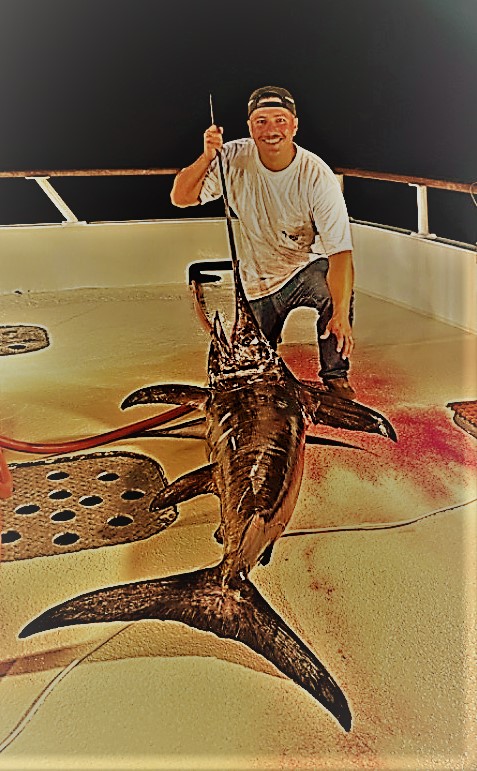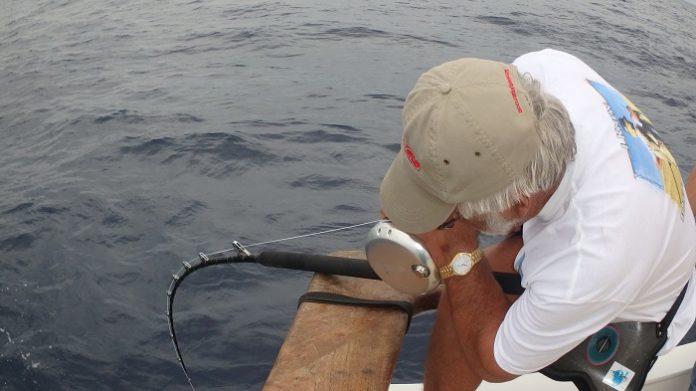BY GUNDY GUNDERSON
SAN DIEGO – One of the great skills of a successful sportfishing captain is the ability to adapt to a constantly changing environment. Weather, swell, current, fish predisposition and tides are perpetually in a state of change. Confronted with a set conditions, a good captain must establish a course of action that will best achieve the goal of putting fish on the deck. Anyone can shake their fist at poor conditions but only the best find a way to work through them.
It is in this spirit that the San Diego long range fleet confronted the once-in-a-lifetime pandemic that turned the sportfishing world on its ear. The boats evolved and found a new way of doing things. After the initial stoppage and lockdown, the fleet formed a plan, working with the Coast Guard and local authorities to establish safe protocols to return to sportfishing. Schedules were altered to shorten trips until working protocols could be established. After the boats strung together a series of shorter trips, longer 7-, 8- and 10- day trips were added back to the schedule.
Life can be serendipitous. At the time the boats needed to re-establish the runs, the bluefin tuna bite off the Southern California bight surged in quality and quantity. The long range boats could target long range-quality fish on shorter-length trips – just what the doctor ordered. It is important to remember that due to the pandemic, the Mexican government declined to issue permits to Guadalupe Island. So the go-to, closest shot at a trophy tuna for the long range fleet had been off limits.
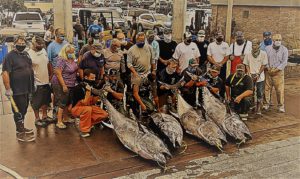
The confluence of state-of-the-art long range boats and big fish tactics and the outstanding bluefin fishery was manna for the fleet. The boats posted spectacular catches reflecting much higher hook-to-land ratios on the bigger fish than local boats. The caliber of long range angler can also be greater, also resulting in higher catch rates. Several recent trips posted multiple catches of super cow tuna in the 300-pound class. A traditional 200-pound cow hardly made a headline. In fact, an argument can be made that more cow and super cow tuna were landed out west this season than in all of last season’s cow trips down to the Hurricane Bank and Buffer Zone.
As fall approached and longer 7- to 10- day trips played out on the schedule, the bluefin fishery remained an important stop on the itinerary. Because of the up and down nature of bluefin tuna feeding behavior, boats on longer trips looked at the state of the bite. If the bite was good, the boat would steam straight out west to the bluefin grounds. After bagging a catch and most likely a jackpot, the boat would sail south targeting warm-water exotics at Alijos Rocks and the high spots that make up the Ridge. Here anglers could target typical fall exotics like wahoo, yellowfin, yellowtail, pargo and grouper.
If the bluefin fishing was off as the boat departed Point Loma, the boat would bee-line down to the Ridge and Rocks, make a catch, then return to the bluefin grounds where the bite was likely on an upswing. The bluefin fishery has provided an excellent option at either end of the trip. Over the course of the last several seasons, the bluefin fishery has greatly altered the course of long range itineraries.
Two of the most successful techniques for taking giant bluefin this season have been kite fishing and deep jigging. They are specific techniques designed to take hard-pulling tuna when they are feeding in two different ways. One targets fish at the surface, the other, down deep. The techniques are designed to make bait presentations directly to the actively feeding bluefin tuna.
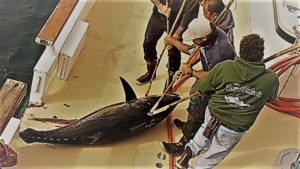
Kite Fishing
The most consistent producer of huge bluefin tuna this year and probably any year, is the kite. It is a presentation tailored for the often boat-shy qualities of bluefin. It is not an easy rig to deploy and is often challenging getting it to work right. But when you have it fishing, it is usually your best shot at a trophy fish. The advantages are many. First, it takes the bait away from the boat, positioning it well down your chum line. The bait presents naturally without the sound and presence of the boat that often puts the skittish fish off. Second, because the bait is carried by the kite rather than merely swam out, There is no line in the water, another bluefin spook. Additionally, this allows for the use of heavy line classes erring on the heavy side. Most kite rigs utilize 200-pound braid with a 300-pound leader. The line can be packed on a big 50W size reel. The combination of a stealth presention of a big bait on heavy tackle is the recipe for success in landing giant blues.
The process can be laborious but the results are undeniable. It is a daily challenge to fly the kite properly. Strength of wind, wind direction changes, current strength and direction all combine to create the atmosphere for flying the kite. Proper baits, favored by the big tuna must be obtained, be it flyers, mackerel or squid. The kite operation has to be synced with the activities of all other anglers on the boat. Lines must be kept clear.
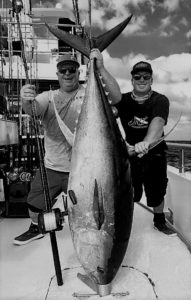
There is also the tedious, wait. Sometimes, you may get bit right away, other times, you may sit there and rot. Other times you get a strike and a miss and the bait is often damaged. In this case, the kite and bait has to be retrieved and a new bait re- rigged. The whole process is labor intensive and highly technical, but the results? Consistent catches of giant bluefin tuna, is indisputable.
How the thing works is like this, the kite is flown on a separate dedicated reel. Electric reels are favored as they make deploying and retrieving the kite much quicker and easier for the crew. To the kite line is attached to a release clip. A bait rod is rigged with at least a 50W reel packed with 200-pound braid and a 200- or 300-pound leader. The baits are often double-line, double-hook rigged.
Once the kite is flying, the line from the bait line is set in the release clip with the bait dangling below. In unison, both the kite and the bait reels are free-spooled and the bait is carried away from the boat. Beginning at around 75-yards aft, the kite is stopped. This distance can vary from long to short based on the preference of the given day or conditions. The bait, dangling from the release clip, is free-spooled so the bait is swimming, or puddling, on the surface. A strip of fluorescent tape is attached at about 5 feet up the line. This is a depth indicator, permitting the angler to keep the bait just below the surface of the water. Additionally, when a tuna takes the bait it serves as a strike indicator, tipping off the angler to a take and when to wind into the fish.

As the angler winds into the fish the line comes tight and pops out of the release clip. The angler must continue to wind until the hook is set in the fish solid. At this point, the bait rod is clear of the kite and the angler will move to the rail and put the wood to the fish. Today’s bait rods are rail rods, and with the heavy tackle and use of the rail, today’s angler can put tremendous pressure on the fish.
For the angler, there are a few important things to do. Identify the strike, then wind like a mad man until the line releases. Upon release from the clip, there will be a bow in the line. It is important to continue winding until the slack is gone and the fish comes tight.
Dawson Short from Pacific Coast Bait and Tackle in Oceanside, a shop expert in offshore fishing, has been on the kite bite quite a bit this summer and offered these suggestions.
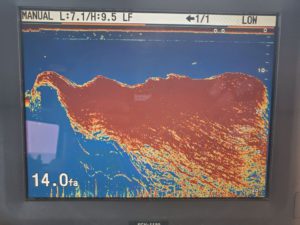
“Everything to do with the kite is handled by the boat and crew. Once the bait is deployed and the kite is set, it is up to the angler to hook the fish. The most important thing the angler can do is keep the bait in the strike zone. With puffs of wind and dips of swell, the bait will come up out of the water or conversely, plunge too deep.”
Short continued, “The angler must keep his or her eye on the strike indicator and make small adjustments by free-spooling the bait when it comes out of the water or winding the bait in when it goes to deep. Constant vigilance will keep the bait in the strike zone but also tip off the angler to the first sign of a strike.”
At strike when the strike indicator goes down, the angler is responsible for setting the hook. The hook-set is accomplished with the reel. “Listen to the crew, and if you are not sure of the strike the crew will holler at you when to wind.” continued Short. “At this point, get a good grip on the rod and reel handle and wind as fast as you can until the clip releases and the line comes tight to the tuna. As the rod loads up, get to the rail” With the fish hooked and clear of the kite, the angler can fight the fish, as he would traditionally with a rail rod.
Many boats on the way out will hold a seminar on the whole process. “The Captain and crews will direct you and keep you informed moment by moment from deployment to hook-set”, said Short. “Listen for directions, execute and you will be fine.”
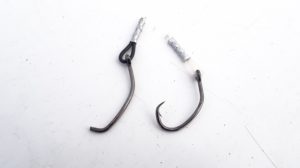
Deep jigging
The deadly Flat-Fall or flutter jig technique has really changed the face of bluefin fishing in recent years. The tantalizing drop of these jigs elicits a reaction from often jig-adverse fish. It is an ideal presentation when the bluefin schools are not on the surface and are feeding deep. This technique is effective during the day or at night and the trend this season has been at night. The fleet has experienced some ripper night bites and the fish have been all big ones. In fact, several super cows were decked recently on the jigs, probably the largest fish you’ll see taken on a jig anywhere. The Shimano Flat-Fall, because of its action and effectiveness has become a proven favorite, but there are other productive jigs like the wider wobbling Daiwa SK.
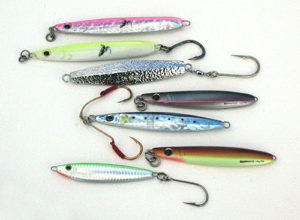
The jig’s size is determined by weight. The proper weight is determined by current and depth. Tom Chapparo, longtime chartermaster on the Polaris Supreme, was fishing the jigs on a recent trip and offered these tips. “ A good starting point for night drops on giant bluefin is a 350-gram jig. In very little current, you might go down in weight, in heavy current you may go up in weight.”
Chapparo offered a few more tips, “I like to mark my braid with a Sharpie every 50 yards or so, this way I can more easily control my depth range. You like to keep your jig where the fish are at. As for lure patterns, I’ve had good luck with the zebra striped and glow colored jigs.”
At 20 or 30 fathoms, the light is low and there really is no finesse. You can fish heavy gear. But with the 300-pound and 400-pound models swimming around, going even higher in line class is requisite. Where a few years ago, 130-pound braid main line was standard on a jig rod, today’s big fish jigging rigs will pack on 200-pound Spectra with a 200- or 300-pound leader on a much larger reel like a 50W.
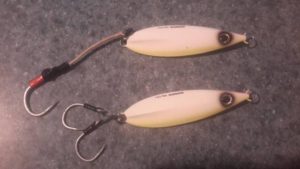
Dawson Short likes this set-up for a big fish jigging, “I suggest 150-pound hollow or 200-pound braid mainline. Make a connection to a 300-pound wind-on leader and crimp the jig on.” Continued Short, “I beef up the hooks with a single 8/0 Owner Jobu hook or tandem 7/0 Gorillas.”
Chapparo wrapped it up like this, “There is no finesse here, you are trying to hook these bigger fish on the heaviest tackle possible. Matching the tackle to the size of fish is how you find success with these jumbo fish.”
